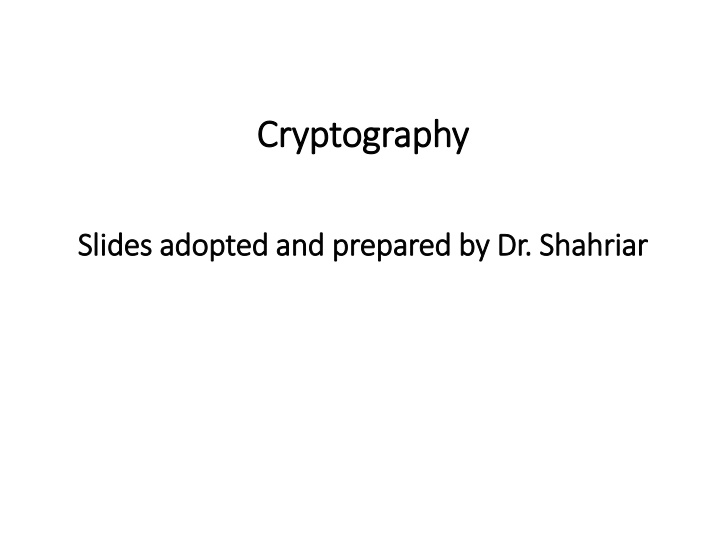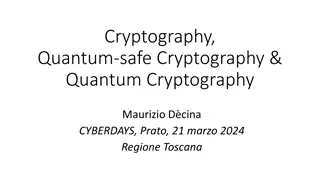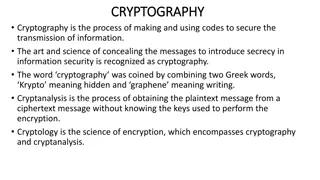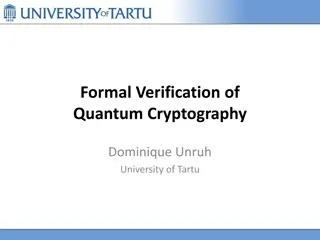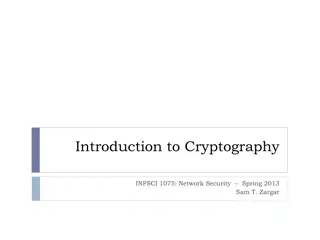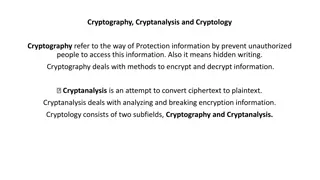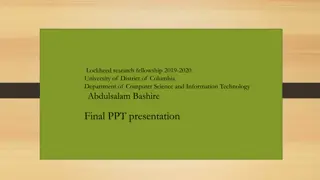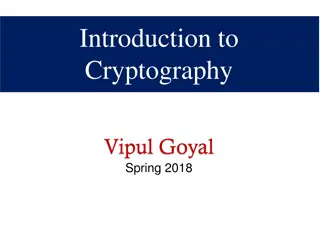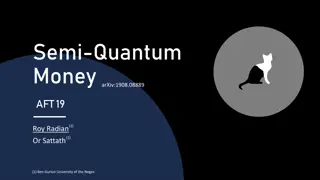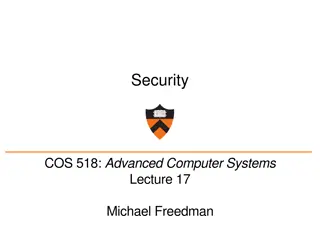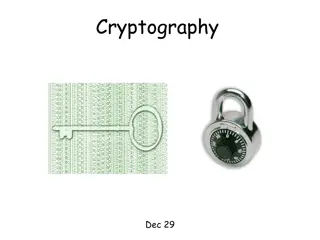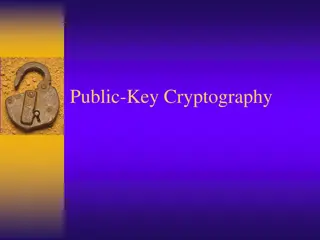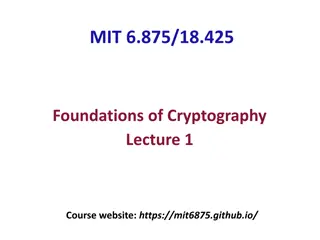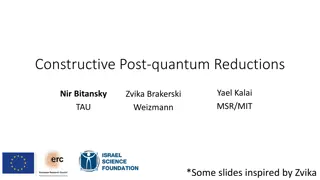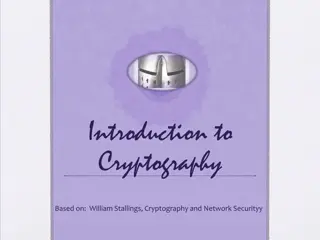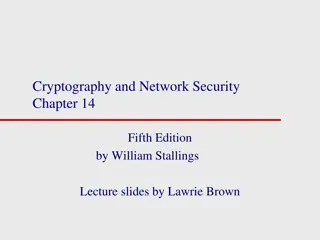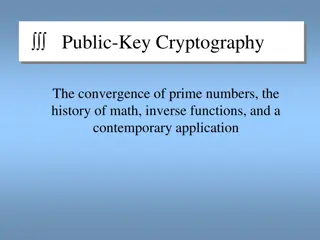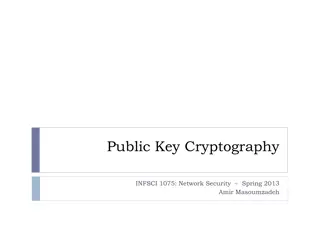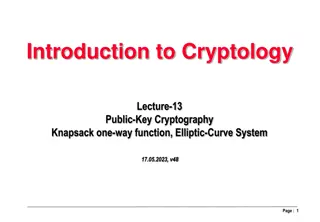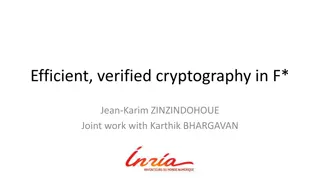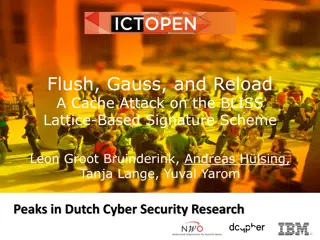Cryptography
Cryptography is the art of securing communication through the use of codes and ciphers. This overview covers fundamental concepts such as symmetric and asymmetric cryptography, hashes, attacks on cryptography, and best practices. Understand the terminologies in cryptography, the use of keys, and the basic assumptions involved. Explore the world of cryptology, which involves making and breaking secret codes. Get insights into different types of ciphers and cryptosystems, like simple substitution and Caesar's cipher. Unveil the importance of key management and the underlying principles that govern cryptographic systems. Dive into the fascinating realm of crypto and enhance your understanding of this crucial field.
Uploaded on Feb 20, 2025 | 0 Views
Download Presentation

Please find below an Image/Link to download the presentation.
The content on the website is provided AS IS for your information and personal use only. It may not be sold, licensed, or shared on other websites without obtaining consent from the author.If you encounter any issues during the download, it is possible that the publisher has removed the file from their server.
You are allowed to download the files provided on this website for personal or commercial use, subject to the condition that they are used lawfully. All files are the property of their respective owners.
The content on the website is provided AS IS for your information and personal use only. It may not be sold, licensed, or shared on other websites without obtaining consent from the author.
E N D
Presentation Transcript
Cryptography Cryptography Slides adopted and prepared by Dr. Slides adopted and prepared by Dr. Shahriar Shahriar
Topics Terminologies and assumption Symmetric cryptography Asymmetric cryptography Hashes Attacks on cryptography
Topics Terminologies and assumption Symmetric cryptography Asymmetric cryptography Hashes Attacks on cryptography and best practices
Crypto Cryptology The art and science of making and breaking secret codes Cryptography making secret codes Cryptanalysis breaking secret codes Crypto all of the above (and more)
Terminologies in Crypto A cipher or cryptosystem is used to encrypt the plaintext The result of encryption is ciphertext We decrypt ciphertext to recover plaintext A key is used to configure a cryptosystem A symmetric key cryptosystem uses the same key to encrypt as to decrypt A public key cryptosystem uses a public key to encrypt and a private key to decrypt
Crypto Basic assumptions The system is completely known to the attacker Only the key is secret That is, crypto algorithms are not secret This is known as Kerckhoffs Principle A Dutch engineer who wrote an article in 1883 Why do we make this assumption? Experience has shown that secret algorithms are weak when exposed Secret algorithms never remain secret Better to find weaknesses beforehand
Crypto as Black Box key key encrypt plaintext plaintext decrypt ciphertext A generic view of symmetric key crypto
Simple Substitution Plaintext: fourscoreandsevenyearsago Key: Plaintext A B C D E F G H I J K L M N O P Q R S T U V W X Y Z Ciphertext D E F G H I J K L M N O P Q R S T U V W X Y Z A B C Ciphertext: IRXUVFRUHDQGVHYHQBHDUVDJR Key: Shift by 3 is Caesar s cipher
Caesars cipher (Simple Substitution) A type of substitution cipher in which each letter in the plaintext is replaced by a letter some fixed number of positions down the alphabet For example, with a left shift of 3, D would be replaced by A, E would become B, and so on. The method is named after Julius Caesar, who used it in his private correspondence.
Not-so-Simple Substitution: before and beyond n=3 Shift by n for some n {0,1,2, ,25} Then key is n Example: key n = 7 Plaintext A B C D E F G H I J K L M N O P Q R S T U V W X Y Z Ciphertext D E F G H I J K L M N O P Q R S T U V W X Y Z A B C
Cryptanalysis I: Try Them All A simple substitution (shift by n) is used But the key is unknown Given ciphertext: CSYEVIXIVQMREXIH How to find the key? Only 26 possible keys try them all! Exhaustive key search Solution: key is n = 4 (forward or backward?) Decrypted text (forward): GWCI (no sense) Decrypted text (backward): YOU ARE (meaningful) Try yourself at http://www.xarg.org/tools/caesar-cipher/
Make the cryptanalysis harder: Least- Simple Simple Substitution In general, simple substitution key can be any permutation of letters Not necessarily a shift of the alphabet For example Plaintext A B C D E F G H I J K L M N O P Q R S T U V W X Y Z Ciphertext D E F G H I J K L M N O P Q R S T U V W X Y Z A B C Then 26! > 288 possible keys! Are we now better off preventing Trudy from decrypting encrypted message using permutation approach instead of shifting?
Cryptanalysis II: Be Clever We know that a simple substitution is used But not necessarily a shift by n Find the key given the ciphertext: PBFPVYFBQXZTYFPBFEQJHDXXQVAPTPQJKTOYQWIPBVWLXTOXBTFXQWAXBVCXQW AXFQJVWLEQNTOZQGGQLFXQWAKVWLXQWAEBIPBFXFQVXGTVJVWLBTPQWAEBF PBFHCVLXBQUFEVWLXGDPEQVPQGVPPBFTIXPFHXZHVFAGFOTHFEFBQUFTDHZBQ POTHXTYFTODXQHFTDPTOGHFQPBQWAQJJTODXQHFOQPWTBDHHIXQVAPBFZQH CFWPFHPBFIPBQWKFABVYYDZBOTHPBQPQJTQOTOGHFQAPBFEQJHDXXQVAVXEB QPEFZBVFOJIWFFACFCCFHQWAUVWFLQHGFXVAFXQHFUFHILTTAVWAFFAWTEVOI TDHFHFQAITIXPFHXAFQHEFZQWGFLVWPTOFFA
Cryptanalysis II Cannot try all 288 simple substitution keys Can we be more clever? English letter frequency counts (E occurs most frequently followed by T, and so on) 0.14 0.12 0.10 0.08 0.06 0.04 0.02 0.00 A C E G I K M O Q S U W Y
Cryptanalysis II Ciphertext: PBFPVYFBQXZTYFPBFEQJHDXXQVAPTPQJKTOYQWIPBVWLXTOXBTFXQWAXBVCXQWAXFQJVWLEQNTOZQG GQLFXQWAKVWLXQWAEBIPBFXFQVXGTVJVWLBTPQWAEBFPBFHCVLXBQUFEVWLXGDPEQVPQGVPPBFTI XPFHXZHVFAGFOTHFEFBQUFTDHZBQPOTHXTYFTODXQHFTDPTOGHFQPBQWAQJJTODXQHFOQPWTBDH HIXQVAPBFZQHCFWPFHPBFIPBQWKFABVYYDZBOTHPBQPQJTQOTOGHFQAPBFEQJHDXXQVAVXEBQPEFZ BVFOJIWFFACFCCFHQWAUVWFLQHGFXVAFXQHFUFHILTTAVWAFFAWTEVOITDHFHFQAITIXPFHXAFQHEFZ QWGFLVWPTOFFA Analyze this message using statistics below Ciphertext frequency counts: replace F with E, Q with T, etc. A B C D E F G H I J K L M N O P Q R S T U V W X Y Z 21 26 6 10 12 51 10 25 10 9 3 10 0 1 15 28 42 0 0 27 4 24 22 28 6 8
Cryptanalysis: secure vs. insecure Cryptosystem is secure if the best known decryption (also considered an attack on the system) by Trudy is to try all keys Exhaustive key search, that is Cryptosystem is insecure if any shortcut attack is known
Double Transposition Plaintext: attackxatxdawn Permute rows and columns Ciphertext: xtawxnattxadakc Key is matrix size and permutations: (3,5,1,4,2) and (1,3,2)
One-Time Pad Each bit or character from the plaintext is encrypted by a secret random key (or pad) of the same length as the plaintext, resulting in a ciphertext. If the key is truly random, as large as or greater than the plaintext, never reused in whole or part, and kept secret, the ciphertext will be impossible to decrypt or break without knowing the key. It has been proven that any cipher with the perfect secrecy property must use keys with the same requirements as One-time pad keys C. Shannon, 1949
One-Time Pad: Example of encryption (modular addition) Assume that Alice would like to send the message "HELLO" to Bob Generate a random key "XMCKL" (equal length of the original message) The numerical values of corresponding message and key letters are added together, modulo 26.
One-Time Pad: Example of decryption (modular subtraction) The ciphertext "EQNVZ is received by Bob who then uses the same key and the same process, but in reverse, to obtain the plaintext The key is subtracted from the Ciphertext, again using modular arithmetic If a number is larger than 26, then the remainder after subtraction of 26 is taken in modular arithmetic fashion If a number is negative then 26 is added to make the number positive.
Codebook Cipher A codebook is a type of document used for gathering and storing codes. A codebook contains a lookup table for coding and decoding; each word or phrase has one or more strings which replace it. To decipher messages written in code, corresponding copies of the codebook must be available at either end. The distribution and physical security of codebooks presents a special difficulty in the use of codes, compared to the other crypto.
Codebook Cipher Example of codebook from history Zimmerman Telegram encrypted via codebook Februar 13605 (february) fest 13732 (party) finanzielle 13850 (financial situation) folgender 13918 (following) Frieden 17142 (friend) Friedenschluss 17149 (peace) During WWII, the German Kriegsmarine (Navy) used a variety of codebooks The caption on the top of the page on the left, reads: Vorsicht! Wasserl slicher Druck! (Careful! Water solvable print!). When left behind in a sinking U-Boot, the codebooks would wipe themselves automatically, which is why it was so hard to capture them.
Next Symmetric Key Same key for encryption and decryption
Feistel Cipher: Encryption German-born physicist and cryptographer Horst Feistel invented while working for IBM (USA) Feistel cipher splits plaintext block into left and right halves: P = (L0,R0) For each round i = 1,2,...,n, compute Li= Ri 1 Ri= Li 1 F(Ri 1,Ki) where F is round functionand Ki is subkey Ciphertext: C = (Ln,Rn) XOR is an example of round function (it is invertible, if you know any two arguments, then you can retrieve the other by xoring the two)
Feistel Cipher: Decryption Start with ciphertext C = (Ln,Rn) For each round i = n,n 1, ,1, compute Ri 1 = Li Li 1 = Ri F(Ri 1,Ki) where F is round functionand Ki is subkey Plaintext: P=(L0,R0) Formula works for any function F But only secure for certain functions F
Data Encryption Standard DES is a Feistel cipher with 64 bit block length 56 bit key length along with 48 bits of key used each round (subkey) 16 rounds of iteration Each round is simple (for a block cipher) Security depends heavily on S-boxes Each S-boxes maps 6 bits to 4 bits
LM encryption LAN Manager hash Hash of a password is computed using a six-step process: 1. Password is converted into all uppercase letters 2. Null characters added to it until it equals 14 characters 3. New password is split into two 7 character halves 4. Values are used to create two DES encryption keys, one from each half with a parity bit added. 5. Each DES key is used to encrypt the ASCII string (KGS!@#$%), resulting in two 8-byte ciphertext 6. The two 8-byte ciphertext values are combined to form a 16-byte value, which is the completed LM hash
LM encryption LAN Manager hash
Data Encryption Standard DESdeveloped in 1970 s Based on IBM s Lucifer cipher DES was U.S. government standard Data encryption using a private (secret) key was judged difficult to break by the U.S. government There are 72,000,000,000,000,000 (72 quadrillion) or more possible encryption keys that can be used. It was restricted for exportation to other countries. DES development was controversial NSA secretly involved Design process was secret Key length reduced from 128 to 56 bits Subtle changes to Lucifer algorithm
Security of DES Security depends heavily on S-boxes Everything else in DES is linear Generate table randomly (mapping 2 bits of row, and 4 bits of column) Thirty+ years of intense analysis has revealed no back door Attacks, essentially exhaustive key search Inescapable conclusions Designers of DES knew what they were doing Designers of DES were way ahead of their time
Advanced Encryption Standard Replacement for DES AES competition (late 90 s) NSA openly involved Transparent process Many strong algorithms proposed Rijndael Algorithm ultimately selected (pronounced like Rain Doll or Rhine Doll ) Iterated block cipher (like DES) Not a Feistel cipher (unlike DES)
AES Overview Block size: 128 bits (others in Rijndael) Key length: 128, 192 or 256 bits (independent of block size) 10 to 14 rounds (depends on key length) Each round uses 4 functions (3 layers ) ByteSub (nonlinear layer) ShiftRow (linear mixing layer) MixColumn (nonlinear layer) AddRoundKey (key addition layer)
IDEA Invented by James Massey One of the giants of modern crypto ETH Zurich IDEA has 64-bit block, 128-bit key IDEA uses mixed-mode arithmetic Combine different math operations IDEA the first to use this approach Frequently used today
Blowfish Blowfish encrypts 64-bit blocks Key is variable length, up to 448 bits Invented by Bruce Schneier Bell Lab, DoD Almost a Feistel cipher Ri = Li 1 Ki Li = Ri 1 F(Li 1 Ki) The round function F uses 4 S-boxes Each S-box maps 8 bits to 32 bits Key-dependent S-boxes S-boxes determined by the key
RC6 Invented by Ron Rivest MIT, CASIL lab A proprietary algorithm by RSA Security Variables Block size Key size Number of rounds An AES finalist Uses data dependent rotations Unusual for algorithm to depend on plaintext
Next Asymmetric Key (or asymmetric crypto) Two keys, one for encryption (public), and one for decryption (private)
Public Key Cryptography Two keys Sender uses recipient s public key to encrypt Recipient uses private key to decrypt Based on one way function One way means easy to compute in one direction, but hard to compute in other direction Example: Given p and q, product N = pq easy to compute, but given N, it s hard to find p and q
Public Key Cryptography Use Encryption Suppose we encrypt messag Mwith Bob s public key Bob s private key can decrypt to recover M Digital Signature Signby encrypting with your private key Anyone can verifysignature by decrypting with public key But only you could have signed Like a handwritten signature, but way better
RSA By Clifford Cocks (GCHQ), independently, Rivest, Shamir, and Adleman (MIT) RSA is the gold standard in public key crypto Let p and q be two large prime numbers Let N = pq be the modulus Let (n) = (p 1)(q 1) Choose e relatively prime to (n) Find d such that e-1 mod (n) Public key is (N,e) Private key is p, q, d
RSA Cryptosystem Message M is treated as a number To encrypt M we compute C = Me mod N To decrypt ciphertext C compute M = Cd mod N Recall that e and N are public If Trudy can factor N=pq, she can use e to easily find d since ed = 1 mod (p 1)(q 1) Factoring the modulus breaks RSA
RSA Example Bob: - chooses p = 101, q = 113 - computes n = pq = 11413 and (n) = (p-1)(q-1) = 11200 - chooses e = 3533 (note: gcd(e, (n))=1) - computes d = e-1mod (n) = 6597 - publishes n and e (keeps p, q, and d private) Alice wants to send 9726 to Bob: - computes 9726e mod n = 97263533 mod 11413 = 5761 - sends 5761 to Bob Bob: - computes 5761dmod n = 57616597 mod 11413 = 9726
Diffie-Hellman Invented by Williamson (GCHQ) and, independently, by D and H (Stanford) A key exchange algorithm Used to establish a shared symmetric key among two parties over an insecure channel Not for encrypting or signing
Diffie-Hellman Public:g and p Private:Alice s exponent a, Bob s exponent b ga mod p gb mod p Alice, a Alice computes (gb)a = gba= gab mod p Bob computes (ga)b = gab mod p Use K = gab mod p as symmetric key Bob, b
Next Hashing
What is hash function? A cryptographic hash function is a hash function that converts a given input data into a message (digest) Hash is a one-way function which makes it impossible recreate the input data from its digest value alone.
MD5 algorithm MD5 algorithm Message Digest algorithm 5 Invented by Ronald Rivest in 1991 Input data can be of any size or length, but the output hash value size is always fixed The algorithm generates a fixed size (32 digit hex) MD5 hash Original algorithm is given here https://www.ietf.org/rfc/rfc1321.txt
MD5 computation command (Linux) MD5 computation command (Linux) cat command creates a new file md5sum command generates MD5 hash
MD5 hash implementation MD5 hash implementation PHP code uses md5() library call Java code uses MessageDigest class
